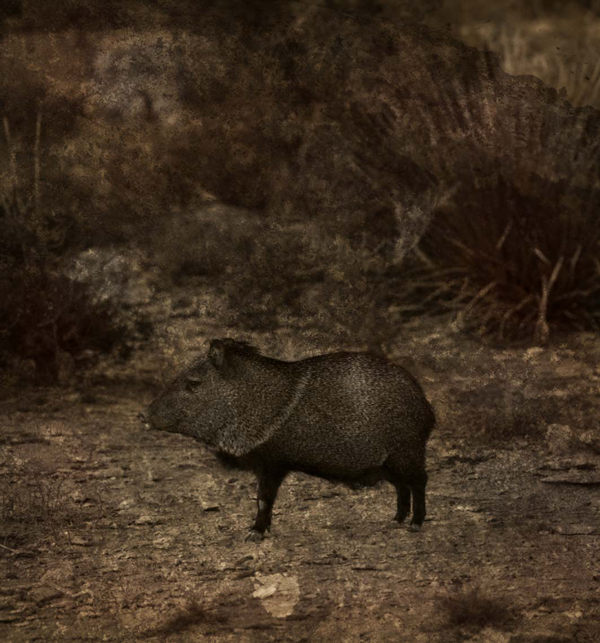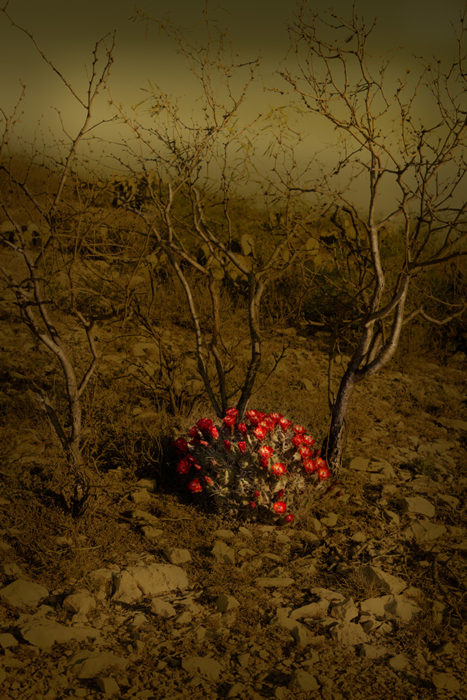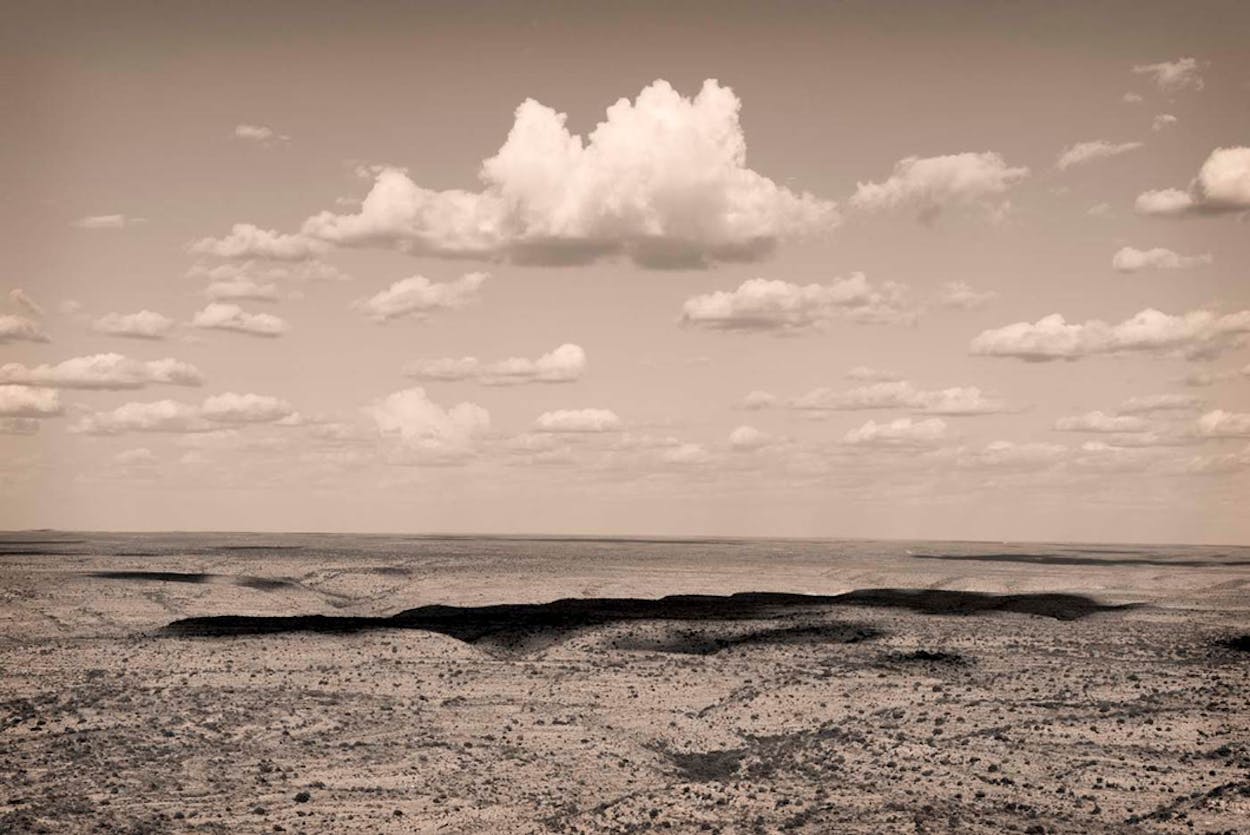Photographer James H. Evans’s favorite shoes are a pair of black, leather wingtips that he spray-painted bronze. He wears them nearly every day, usually with a dark suit, an ensemble that makes a certain sense when he’s shooting wintertime portraits in Marathon, where he lives, but less when he’s photographing landscapes in summer in nearby Big Bend National Park, where temperatures can hit 100 degrees by ten a.m. During those excursions, which he takes frequently and for weeks at a time, he’ll actually sleep in his suit on top of his pickup truck’s camper shell. From that spot it’s easier to wake and gauge the night sky, which lights his time-lapse photos of the desert in the dark, and he’s safely away from any creatures that might like to find him asleep on the ground. Not that he’s especially unnerved by things that creep and crawl. The first of his photographs to appear in Texas Monthly (“State of the Art,” September 1992), was from a series showing snakes, lizards, and spiders climbing over the furniture in his recently deceased landlady’s home.
So one would be justified in supposing Evans has a broadly defined comfort zone. Not necessarily. His latest series of work, one-hundred-some-odd photos that he took of an 11,000-acre ranch on the Pecos River through the course of 2013, grew from a project that he initially found daunting. The ranch owner, a Texas businessman who prefers to go unidentified—but is enough of an Evans fan that he agreed to let the photos be published—first started visiting Evans’s gallery in early 2011. He wanted Evans to capture his land, to create images that would fill his modern ranch house then under construction. Evans put him off for two years, but then finally agreed to visit the ranch, roughly 100 miles east of Marathon. “It was really different for me,” says Evans. “There are no mountains. There’s water you can get to every day, and it rains a lot more, which creates a lot of color. And really, looking at the ranch house, I just went, ‘Damn.’ It’s huge—huge! With all dry-stacked walls, inside and out. One mason was chipping rock and placing it. This was a multimillion-dollar project. I’d have to live up to that.”
But Evans liked the guy. On that first visit, the ranch owner cooked dinner for the construction crew himself. On another, he introduced Evans to his extended family. “One morning, his granddaughter put stickers on his face,” says Evans, “and he wore them all day. I loved that.”
Knowing he’d have to give up Big Bend for a while to do the project right, Evans drew up a pie-in-the-sky proposal. He’d spend a week each month at the ranch for one calendar year so that he could shoot it in all seasons. He wanted access to a helicopter to take aerial shots and a sizable budget to pursue any other wild-hair ideas that came to mind. He also needed extended time with the owner to learn what he loved about the ranch. “I was looking at the landscape, thinking, ‘What does he see that I don’t see?’ But I also had to show him things he hadn’t seen. I wanted him to say, ‘Wow, that’s on my ranch?’” The owner signed on, but provided no more guidance than “Go take some pictures.” In February 2013, Evans’s work got underway. “I think the first photograph I took was me on the porch, thinking, ‘What the hell am I going to do?’”
At first he seemed trapped in a gap between the landscape he was used to and one he was trying to learn. He shot a lot of ocotillos, the spindly shrubs that spring from the desert floor in bunches like coarse hairs from a mole, a longtime favorite subject. But they grew differently on the Pecos, breaking up into little branches at the top. “I thought they were misfits compared to Big Bend. They looked weirder, all scraggly.” As spring came on, though, and he saw the place change, he started to get a feel for it. “A storm came one night when I was down on the river and I thought, ‘I should probably leave.’ By the time I got to the house, lightning was crashing all around me, and it scared the shit out of me to tell you the truth. I actually parked inside the house. And then I started feeling like I really knew the ranch.”
He began to concentrate on what was there. He shot in the morning fog instead of waiting for it to lift. He photographed every flower he could find, wide swaths of purple cenizo bushes and two—the only ones—that bloomed white. He sat at the river waiting for wild horses to come water or up on the promontory waiting for clouds to throw shadows. To his eye the landscape lacked the stark drama he was used to, so when he was back in Marathon editing, he started manipulating the images. He exaggerated colors and muted backgrounds. He blended photos, subtly overlaying the outlines of rock formations on otherwise clear skies. “I started exploring different things I could do. I wanted texture. I wanted the images to look like paintings instead of photographs.” The most striking experiments came from the helicopter. He shot one-hundred-foot stretches of the river, then lined them side-by-side in a single frame. The jagged, line-riven “River Triptychs,” as Evans calls them, are uncharacteristically abstract. They look as likely to be ripped tree bark as riverbank. To Evans they just look like the ranch.
He took his last photos in January as planned, though he and the owner are still deciding which ones to keep and where to hang them in the house. The end result will be a collection unlike anything Evans has done before, save for a few notable exceptions that hark back to earlier work. The owner has selected a portrait of a rattlesnake coiled at the base of a yucca and a black and white image of a rabbit stretching in the middle of a ranch road, photos that read like inside jokes to admirers of Evans’s Big Bend work. But the great majority is wholly new, and Evans calls it his masterpiece. “This is the first time someone’s believed in me and let me run wild. I got to explore and be totally myself. No rules. It’s a big body of images, the full range of what I can do, and my personality comes through in everything.
“It’s so weird to think that somewhere out there is this million-dollar house that’s full of my photographs. It’s like a museum. In the middle of nowhere. That’s such an anomaly, and such a part of how West Texas is.”

Fireworks Ocotillo
On the Fourth of July, I was invited with the family to go down on the river for the celebration. I made this image, and it looked to me like an Ocotillo when I printed it. We printed it as a plant for the master bedroom, and it is sixty inches tall.
 Landscape Panoramic
Landscape Panoramic
This project put me outside nearly all day and all night long for one hundred days of the year. This is one of those fleeting moments when the sun is setting and the sky is full of clouds, and it flags the light to create a deep dark sky and a bright foreground. Those moments make me happy to be alive and bear witness. Even better when I am fast with the camera. (Click the image for a larger version.)

Javelina
I have never used long lenses. I like the right-in-your-face approach to photography, but for this project I purchased two zoom lenses. It allowed me distance from animals so I could photograph them naturally and without fear. (The animals, I mean, for I am fearless as long as I am looking through a viewfinder.) I photographed many textures of the ranch and incorporated them subliminally in the images. In this instance, not too subliminally—I was going for iconic.
 Yoga Bunny
Yoga Bunny
Again, the use of long lenses made this funny image of the bunny stretching possible. I truly love to watch animal behavior when they are unaware of being observed. It reminded me of my own little yoga bunny, Marci.
 River Triptych
River Triptych
I flew around in a helicopter with a great pilot. This is the ultimate answer to the drone camera craze. I did aerials of the river and pieced them together as triptychs. They are abstract and look beautiful together. We are doing a set of eight large images for the doorway entrance.
 Cactus in Bloom
Cactus in Bloom
There was only this one cactus I saw blooming on the ranch. Michael, an observant ranch hand and amateur photographer, noticed it too. We often compared notes, and he would show me what I missed on his iPhone. The background was dull in comparison, and, exploring the digital age, I enhanced it through a painterly color.
 Fireflies
Fireflies
Coming from analog cameras and film, learning how digital sensors react to light is an ongoing process. For example, if there’s a blue light fifty feet away but it still glows faintly on your skin, digital sensors will read it. Film was never that discerning. So when I saw these little fireflies glowing in the reeds of the river, I knew I could record it.

Ocotillo and Stars
This is one of the first images I made on the ranch. I started in February, and the landscape was stark. Leaves and flowers had not begun to bloom yet. There was no moon, or not much of one, so I was able to record the night sky. I painted the ocotillo with a light and made this image.
 Road With Blue Sky
Road With Blue Sky
I felt like it would be important to try and surprise the ranch owners by finding things on their ranch that maybe they didn’t know was there. I found a grove of trees near the fence line and spent a few hours there and went back several times in different light to photograph it too. At the same time I wanted to show them things they see every day, but with an artistic perspective. Nothing is more common that riding down your own bladed road. So I shot this through my truck window and incorporated a ranch texture in the sky. I’m hoping now, when they ride the road at night, they think of this image.
All photographs copyright James H. Evans. For more of his work, click here.








